Gelatinous zooplankton
Gelatinous zooplankton are fragile animals that live in the water column in the ocean. Their delicate bodies have no hard parts and are easily damaged or destroyed.[2] Gelatinous zooplankton are often transparent.[3] All jellyfish are gelatinous zooplankton, but not all gelatinous zooplankton are jellyfish. The most commonly encountered organisms include ctenophores, medusae, salps, and Chaetognatha in coastal waters. However, almost all marine phyla, including Annelida, Mollusca and Arthropoda, contain gelatinous species, but many of those odd species live in the open ocean and the deep sea and are less available to the casual ocean observer.[4] Many gelatinous plankters utilize mucous structures in order to filter feed.[5] Gelatinous zooplankton have also been called "Gelata".[6]

As prey
| Part of a series on |
| Plankton |
|---|
 |
Jellyfish are slow swimmers, and most species form part of the plankton. Traditionally jellyfish have been viewed as trophic dead ends, minor players in the marine food web, gelatinous organisms with a body plan largely based on water that offers little nutritional value or interest for other organisms apart from a few specialised predators such as the ocean sunfish and the leatherback sea turtle.[7][1] That view has recently been challenged. Jellyfish, and more gelatinous zooplankton in general, which include salps and ctenophores, are very diverse, fragile with no hard parts, difficult to see and monitor, subject to rapid population swings and often live inconveniently far from shore or deep in the ocean. It is difficult for scientists to detect and analyse jellyfish in the guts of predators, since they turn to mush when eaten and are rapidly digested.[7] But jellyfish bloom in vast numbers, and it has been shown they form major components in the diets of tuna, spearfish and swordfish as well as various birds and invertebrates such as octopus, sea cucumbers, crabs and amphipods.[8][1] "Despite their low energy density, the contribution of jellyfish to the energy budgets of predators may be much greater than assumed because of rapid digestion, low capture costs, availability, and selective feeding on the more energy-rich components. Feeding on jellyfish may make marine predators susceptible to ingestion of plastics."[1]
As predators
According to a 2017 study, narcomedusae consume the greatest diversity of mesopelagic prey, followed by physonect siphonophores, ctenophores and cephalopods.[9] The importance of the so called "jelly web" is only beginning to be understood, but it seems medusae, ctenophores and siphonophores can be key predators in deep pelagic food webs with ecological impacts similar to predator fish and squid. Traditionally gelatinous predators were thought ineffectual providers of marine trophic pathways, but they appear to have substantial and integral roles in deep pelagic food webs.[9]
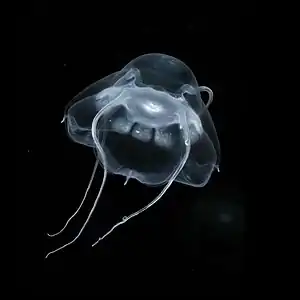 Gelatinous zooplankton like this narcomedusan can be key predators in deep pelagic food webs
Gelatinous zooplankton like this narcomedusan can be key predators in deep pelagic food webs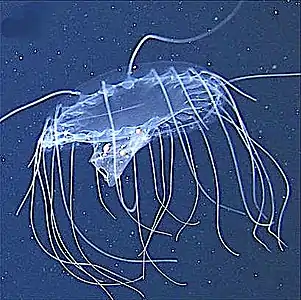 Narcomedusa ingesting a salp chain
Narcomedusa ingesting a salp chain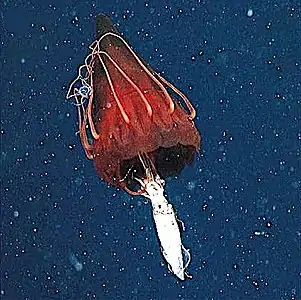 Helmet jellyfish feeding on an armhook squid
Helmet jellyfish feeding on an armhook squid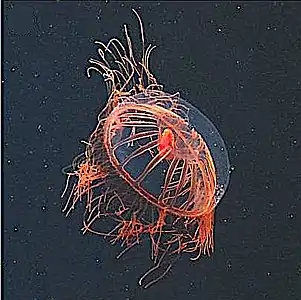 Trachymedusa with a large red mysid in its gut
Trachymedusa with a large red mysid in its gut
The jelly pump and the carbon cycle
Thaliaceans, a class of tunicates, play an important role in the ecology of the sea. Their dense faecal pellets sink to the bottom of the oceans and this may be a major part of the worldwide carbon cycle.[10]
Monitoring
Because of its fragile structure, image acquisition of gelatinous zooplankton requires the assistance of computer visioning. Automated recognition of zooplankton in sample deposits is possible by utilising technologies such as Tikhonov regularization, support vector machines and genetic programming.[11]
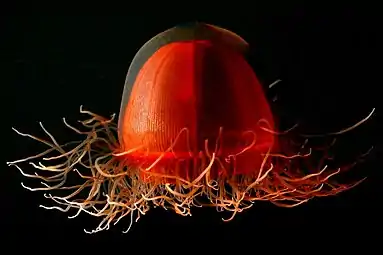
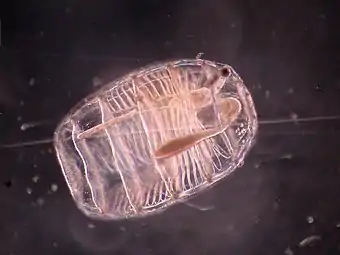
.jpg.webp) The salp, another example of a gelatinous tunicate, is often found in the form of a colonial chain
The salp, another example of a gelatinous tunicate, is often found in the form of a colonial chain
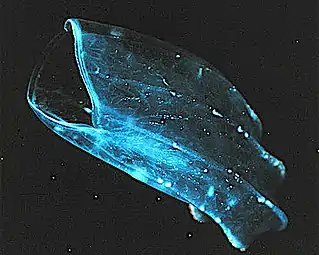 The Beroe ctenophore, mouth gaping, preys on other ctenophores
The Beroe ctenophore, mouth gaping, preys on other ctenophores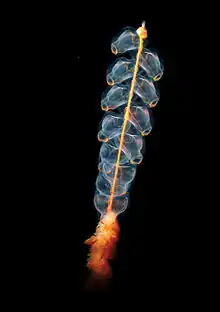 Marrus orthocanna, a pelagic colonial siphonophore
Marrus orthocanna, a pelagic colonial siphonophore
See also
References
- Hays, Graeme C.; Doyle, Thomas K.; Houghton, Jonathan D.R. (2018). "A Paradigm Shift in the Trophic Importance of Jellyfish?". Trends in Ecology & Evolution. 33 (11): 874–884. doi:10.1016/j.tree.2018.09.001. PMID 30245075.
- Lalli, C.M. & Parsons, T.R. (2001) Biological Oceanography. Butterworth-Heinemann.
- Johnsen, S. (2000) Transparent Animals. Scientific American 282: 62-71.
- Nouvian, C. (2007) The Deep. University of Chicago Press.
- Hamner, W. M.; Madin, L. P.; Alldredge, A. L.; Gilmer, R. W.; Hamner, P. P. (1975). "Underwater observations of gelatinous zooplankton: Sampling problems, feeding biology, and behavior1". Limnology and Oceanography. 20 (6): 907–917. Bibcode:1975LimOc..20..907H. doi:10.4319/lo.1975.20.6.0907. ISSN 1939-5590.
- HADDOCK, S.D.H. (2004) A golden age of gelata: past and future research on planktonic ctenophores and cnidarians. Hydrobiologia 530/531: 549-556.
- Hamilton, G. (2016) "The secret lives of jellyfish: long regarded as minor players in ocean ecology, jellyfish are actually important parts of the marine food web". Nature, 531(7595): 432-435. doi:10.1038/531432a
- Cardona, L., De Quevedo, I.Á., Borrell, A. and Aguilar, A. (2012) "Massive consumption of gelatinous plankton by Mediterranean apex predators". PLOS ONE, 7(3): e31329. doi:10.1371/journal.pone.0031329
- Choy, C.A., Haddock, S.H. and Robison, B.H. (2017) "Deep pelagic food web structure as revealed by in situ feeding observations". Proceedings of the Royal Society B: Biological Sciences, 284(1868): 20172116. doi:10.1098/rspb.2017.2116.
 Material was copied from this source, which is available under a Creative Commons Attribution 4.0 International License.
Material was copied from this source, which is available under a Creative Commons Attribution 4.0 International License. - Thaliaceans and the carbon cycle
- Lorenzo Corgnati; Simone Marini; Luca Mazzei; Ennio Ottaviani; Stefano Aliani; Alessandra Conversi; Annalisa Griffa (2016). "Looking inside the Ocean: Toward an Autonomous Imaging System for Monitoring Gelatinous Zooplankton". Sensors. 12 (16): 2124. doi:10.3390/s16122124. ISSN 1424-8220. OCLC 8148647236. PMC 5191104. PMID 27983638. Archived from the original on April 15, 2020 – via DOAJ.CS1 maint: uses authors parameter (link)
- Raskoff, K., and R. Hopcroft (2010). Crossota norvegica. Arctic Ocean Diversity. Accessed 25 August 2020.
External links
- Plankton Chronicles Short documentary films & photos
- Ocean Explorer: Gelatinous zooplankton from the Arctic Ocean
- Jellyfish and other gelatinous zooplankton
- PLANKTON NET: information on all types of plankton including gelatinous zooplankton
- Deep-sea gelatinous zooplankton from The Deep (Nouvian, 2007)
